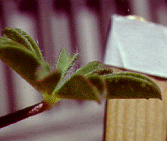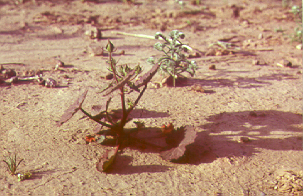Heliotropic Leaf Movements in Plants
Many plant species, especially those in the Leguminosae and Malvaceae have
the ability to orient their leaves in relation to the sun's direct rays. These
movements can be classified as tracking the sun (diaheliotropism), or avoiding
the sun (paraheliotropism). Tracking the sun maximizes the amount of direct
solar radiation a leaf recieves, while paraheliotropism reduces the amount a
leaf receives. These leaf movements are not growth movements, rather they are
rapid, reversible movements in response to turgor changes in cells in an organ
at the base of the leaf petiole called a pulvinus. Many desert annuals, plants
that grow in response to unpredictable rains show heliotropic movements. These
tracking movements can increase radiation interception, photosynthesis and growth
rates - advantageous properties in an ephemeral environment. Some of these annuals
also show paraheliotropism in response to water stress, thus, extending life
by reducing leaf temperatures and water loss as soils dry out.
 This is an animation
constructed frompictures taken every 5 minutes over a 45 minute span. A soybean
(Glycine max) leaf was held horizontally under a bright light. The leaf
rapidly moves into a vertical position (paraheliotropism). The pictures were
put in reverse order at the end of the animation to show the complete cycle
of movement.
This is an animation
constructed frompictures taken every 5 minutes over a 45 minute span. A soybean
(Glycine max) leaf was held horizontally under a bright light. The leaf
rapidly moves into a vertical position (paraheliotropism). The pictures were
put in reverse order at the end of the animation to show the complete cycle
of movement.
These are pictures of two desert annuals in Death Valley, CA. On the left is
Eremalche rotundifolium, a solar tracker in the Malvaceae family. On
the right is Lupinus arizonicus, a leguminous plant that shows a mixture
of tracking and paraheliotropism, depending upon its water status.

Here is a series of pictures taken at midday every day during a drought cycle.
The lupine starts with a fully saturated pot, and over a 9 day period dries
out. Each day, the leaf cups more, reducing midday irradiance. The pulvinus
can be seen as a swelling of a lighter color at the base of the leaflets. The
same 9 pictures are used in reverse order in the animation, to show the full
cycle of movement.
 This is an animation
constructed frompictures taken every 5 minutes over a 45 minute span. A soybean
(Glycine max) leaf was held horizontally under a bright light. The leaf
rapidly moves into a vertical position (paraheliotropism). The pictures were
put in reverse order at the end of the animation to show the complete cycle
of movement.
This is an animation
constructed frompictures taken every 5 minutes over a 45 minute span. A soybean
(Glycine max) leaf was held horizontally under a bright light. The leaf
rapidly moves into a vertical position (paraheliotropism). The pictures were
put in reverse order at the end of the animation to show the complete cycle
of movement.
